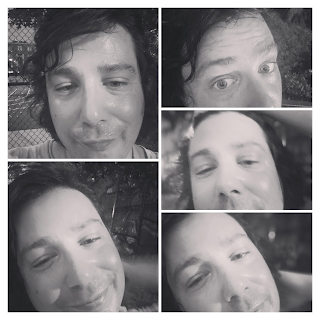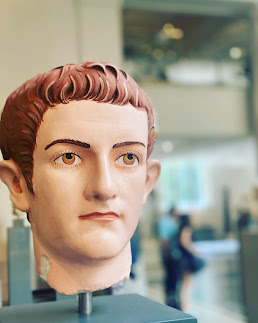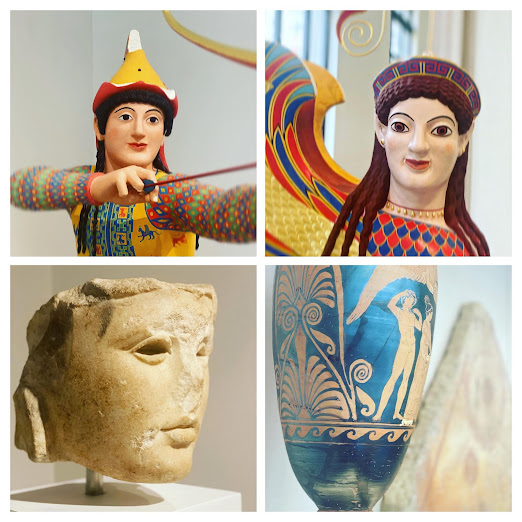 |
| Collage of the Author Created During the Heatwave of 2022. |
Hi, I’m Greig — welcome! Here you’ll find sharp writing, creative ideas, and standout resources for teaching, thinking, making, and dreaming in the middle and high school ELA and Humanities classroom (Grades 6–12).
22.7.22
Heat Stroke Diary #34876: The Summer of 2022 and My Oscillating Fan is on High Alert
 I am an educator and a writer. I was born in Louisiana and I now live in the Big Apple. My heart beats to the rhythm of "Ain't No Place to Pee on Mardi Gras Day". My style is of the hot sauce variety. I love philosophy sprinkles and a hot cup of café au lait.
I am an educator and a writer. I was born in Louisiana and I now live in the Big Apple. My heart beats to the rhythm of "Ain't No Place to Pee on Mardi Gras Day". My style is of the hot sauce variety. I love philosophy sprinkles and a hot cup of café au lait.
14.7.22
Aesthetic Thursday: "You Got Color, Girl?" Chroma Exhibition at the Metropolitan Museum of Art
 |
| Greig poses in front of a young Marcus Aurelius in the Ancient Greek and Roman wing of the Metropolitan Museum of Art in New York City. |
 |
| Marble head of the youthful Marcus Aurelius ca. C.E. 138. |
But go to a museum today, and you see staid marble and what appears to be a vast collection of grays, browns, and three-dimensional black and white photographs. But the pigments and paints decay. And the weathering of the seasons and the march of time have made most color drain away.
But the coloration is still there, in small traces — which the Chroma exhibition at the Metropolitan Museum of Art has attempted to recapture — to see ancient artworks in color again. Alas, you won’t see the now lost statue of Zeus at Olympia, but you will see that same artist’s head of Athena, which at one time had ebony eyes. I especially liked the bronze warriors. And the Sphinx in color was fantastic.
If you have a moment and you are in New York — take a moment and experience these reconstructions done by Prof. Dr. V. Brinkmann & Dr. U. Koch-Brinkmann. @metmuseum @metgreekandroman
 |
| Reconstruction of a marble portrait of the Emperor Gaius Julius Caesar Augustus Germanicus, known as Caligula, Variant B. |
 | ||||
| [1] Reconstruction the bronze statue from the Quirinal in Rome of the so-called Terme Rule. [2] Reconstruction of bronze Riace Warrior (mid-view detail). |
 I am an educator and a writer. I was born in Louisiana and I now live in the Big Apple. My heart beats to the rhythm of "Ain't No Place to Pee on Mardi Gras Day". My style is of the hot sauce variety. I love philosophy sprinkles and a hot cup of café au lait.
I am an educator and a writer. I was born in Louisiana and I now live in the Big Apple. My heart beats to the rhythm of "Ain't No Place to Pee on Mardi Gras Day". My style is of the hot sauce variety. I love philosophy sprinkles and a hot cup of café au lait.
30.6.22
Clip Art: Cosmic School Teacher
 I am an educator and a writer. I was born in Louisiana and I now live in the Big Apple. My heart beats to the rhythm of "Ain't No Place to Pee on Mardi Gras Day". My style is of the hot sauce variety. I love philosophy sprinkles and a hot cup of café au lait.
I am an educator and a writer. I was born in Louisiana and I now live in the Big Apple. My heart beats to the rhythm of "Ain't No Place to Pee on Mardi Gras Day". My style is of the hot sauce variety. I love philosophy sprinkles and a hot cup of café au lait.
1.6.22
Clip Art: The Greek God Dionysos (Bacchus) and Panther
 I am an educator and a writer. I was born in Louisiana and I now live in the Big Apple. My heart beats to the rhythm of "Ain't No Place to Pee on Mardi Gras Day". My style is of the hot sauce variety. I love philosophy sprinkles and a hot cup of café au lait.
I am an educator and a writer. I was born in Louisiana and I now live in the Big Apple. My heart beats to the rhythm of "Ain't No Place to Pee on Mardi Gras Day". My style is of the hot sauce variety. I love philosophy sprinkles and a hot cup of café au lait.
30.5.22
Doing and Being Well: Summer Reading Campaign
 |
| The Summer Reading campaign "Doing and Being Well" is available as an educational digital download on my TpT store. |
Summer is finally here, and for many of us, that means taking a well-deserved break from the demands of school or work. However, even though the academic year has ended, we should continue learning and growing. Reading is one of the best ways to expand our minds and stay engaged during the summer.
Fortunately, many schools and libraries recognize the importance of summer reading and publish campaigns to promote it. However, not all summer reading lists are created equal. If you're looking for a summer reading campaign designed to engage and challenge students while supporting their critical thinking skills, look no further than this comprehensive campaign created by a thoughtful educator.
Design an Immersive Campaign that Provides Plenty of Resources
 |
| Create an easy-to-read newsletter and poster to promote your reading initiative. |
In addition to the book list, the campaign includes a "One Book" project focusing on Sean Covey's 7 Habits of Highly Effective Teens, a popular and engaging book that teaches valuable life skills that apply to students of all ages. The campaign also features grade-level books specifically chosen to engage students at different levels of reading ability, from "Heroes, Gods, and Monsters" for 7th graders to "How to Read Literature Like a Professor" for 12th graders.
Summer Reading Project Options
Finally, the campaign includes a bibliography with links to all the books mentioned in the campaign and additional resources to complement the theme of being and doing well. This comprehensive and thoughtful campaign provides everything you need to promote summer reading and keep students engaged and motivated throughout the summer months.
But why is summer reading so important, anyway?
 |
| Google Forms offers a compelling way to collect student work. |
But summer reading isn't just important for academic reasons. Reading can also be a valuable source of pleasure and relaxation during the summer months, helping to reduce stress and promote mental health. Whether reading for pleasure or for academic purposes, summer reading is a great way to stay engaged and continue learning throughout the summer.
In conclusion, if you're looking for a summer reading campaign designed to engage and challenge students while supporting their critical thinking skills, look no further than this comprehensive campaign. With a wide range of resources, including grade-level books, project options, rubrics, and more, this campaign provides everything you need to promote summer reading and keep students engaged and motivated throughout the summer months.
 I am an educator and a writer. I was born in Louisiana and I now live in the Big Apple. My heart beats to the rhythm of "Ain't No Place to Pee on Mardi Gras Day". My style is of the hot sauce variety. I love philosophy sprinkles and a hot cup of café au lait.
I am an educator and a writer. I was born in Louisiana and I now live in the Big Apple. My heart beats to the rhythm of "Ain't No Place to Pee on Mardi Gras Day". My style is of the hot sauce variety. I love philosophy sprinkles and a hot cup of café au lait.
6.4.22
POV: Counting Time as a School Secretary (If You Are Seated at the Front Desk)
 |
| Point-of-View: The Main Hallway of a School as Seen by the School Secretary |
 |
| Ms. Lauren Yandow walks down the main hallway with her kindergarteners and waves to the school secretary. |
 I am an educator and a writer. I was born in Louisiana and I now live in the Big Apple. My heart beats to the rhythm of "Ain't No Place to Pee on Mardi Gras Day". My style is of the hot sauce variety. I love philosophy sprinkles and a hot cup of café au lait.
I am an educator and a writer. I was born in Louisiana and I now live in the Big Apple. My heart beats to the rhythm of "Ain't No Place to Pee on Mardi Gras Day". My style is of the hot sauce variety. I love philosophy sprinkles and a hot cup of café au lait.
30.3.22
Video Repost: On Generation Z and the Art of Teaching (Or, What It Will Be Like to Have Gen Z as a Teacher)
In this post, I talk about Generation Z, TikTok, and What It Might Be Like to have a Generation Z teacher in twenty years.
Generation Z has been making waves in the social media landscape, particularly on platforms like TikTok. This cohort of digital natives has embraced this platform as a way to express their creativity and engage with others around the world. From funny videos to dance challenges and pranks, Gen Z'ers are taking full advantage of the freedom that comes with creating their own content on TikTok.
A closer look at how Gen Z-ers use TikTok reveals some interesting insights about this generation's behavior and preferences regarding social media platforms. For example, it appears that members of Generation Z prefer short video clips (less than 30 seconds) over longer format ones; they often post comedic content or take part in trends or challenges; they also love creating "duets" — videos posted by other users which allow them to join in on someone else's original post and responding to comments left by other users.
TikTok is not just used for fun, though — many members of Generation Z have found success by utilizing its features for marketing purposes.
Brands such as Nike have seen great success partnering up with popular creators who leverage their large following base across different demographics while giving exposure to new products and services offered by these companies. Additionally, influencers have made money directly from sponsored posts and collaborations via partnerships/brand deals available through TikTok's "For You" page (the main page where all recommended videos are posted).
Such lucrative opportunities might explain why more companies are now turning towards this platform for promotional campaigns targeting young people specifically due to its ability for rapid reach within a matter of days!
Overall, Gen-Z has proven itself adept at capitalizing upon the wide range of possibilities provided by social media platforms like TikTok - whether it be entertainment value or financial gain - making them an ever more important factor in today's marketplace environment moving forward into 2021 and beyond!
 I am an educator and a writer. I was born in Louisiana and I now live in the Big Apple. My heart beats to the rhythm of "Ain't No Place to Pee on Mardi Gras Day". My style is of the hot sauce variety. I love philosophy sprinkles and a hot cup of café au lait.
I am an educator and a writer. I was born in Louisiana and I now live in the Big Apple. My heart beats to the rhythm of "Ain't No Place to Pee on Mardi Gras Day". My style is of the hot sauce variety. I love philosophy sprinkles and a hot cup of café au lait.




